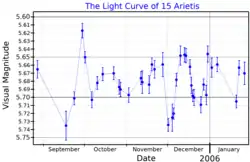| Observation data Epoch J2000 Equinox J2000 | |
|---|---|
| Constellation | Aries |
| Right ascension | 02h 10m 37.59642s[2] |
| Declination | +19° 30′ 01.2099″[2] |
| Apparent magnitude (V) | 5.67 - 5.74[3] |
| Characteristics | |
| Spectral type | M3 III[1] |
| U−B color index | +1.91[4] |
| B−V color index | +1.64[4] |
| Variable type | SRs[3] |
| Astrometry | |
| Radial velocity (Rv) | +62.04 ± 0.22[5] km/s |
| Proper motion (μ) | RA: +87.88[2] mas/yr Dec.: -27.82[2] mas/yr |
| Parallax (π) | 5.84 ± 0.49 mas[2] |
| Distance | 560 ± 50 ly (170 ± 10 pc) |
| Absolute magnitude (MV) | −0.9[6] |
| Details | |
| Mass | 1.4[6] M☉ |
| Radius | 87[6] R☉ |
| Luminosity | 781[7] L☉ |
| Temperature | 3,565[7] K |
| Other designations | |
| Database references | |
| SIMBAD | data |
15 Arietis (abbreviated 15 Ari) is a single[8] variable star in the northern constellation of Aries. 15 Arietis is the Flamsteed designation; it also bears the variable star designation AV Arietis. It has an apparent visual magnitude of 5.74,[8] which is just bright enough to be visible to the naked eye from dark suburban skies. An annual parallax shift of 5.84 mas[2] corresponds to a physical distance of approximately 560 light-years (170 parsecs) from Earth. At that distance, the star's brightness is reduced by 0.33[5] in magnitude because of extinction from interstellar gas and dust.
This is a red giant star with a stellar classification of M3 III.[1] The measured angular diameter of this star is 3.67 ± 0.11 mas.[9] At the estimated distance of Delta Ophiuchi,[2] this yields a physical size of about 67 times the radius of the Sun.[10] The radius determined from the observed brightness and colour of the star is 87 R☉.[6]
15 Arietis is a short period semiregular variable with the designation AV Arietis. The period given in the General Catalogue of Variable Stars is 5.032 days.[3] Longterm photometry finds that the strongest pulsation period is 18.1 days with an amplitude of 0.028 magnitudes, while a second is 21.9 days and 0.030 in magnitude.[1]
References
- 1 2 3 4 Tabur, V.; et al. (December 2009), "Long-term photometry and periods for 261 nearby pulsating M giants", Monthly Notices of the Royal Astronomical Society, 400 (4): 1945–1961, arXiv:0908.3228, Bibcode:2009MNRAS.400.1945T, doi:10.1111/j.1365-2966.2009.15588.x, S2CID 15358380.
- 1 2 3 4 5 6 7 van Leeuwen, F. (November 2007), "Validation of the new Hipparcos reduction", Astronomy and Astrophysics, 474 (2): 653–664, arXiv:0708.1752, Bibcode:2007A&A...474..653V, doi:10.1051/0004-6361:20078357, S2CID 18759600.
- 1 2 3 Samus, N. N.; Durlevich, O. V.; et al. (2009). "VizieR Online Data Catalog: General Catalogue of Variable Stars (Samus+ 2007-2013)". VizieR On-line Data Catalog: B/GCVS. Originally Published in: 2009yCat....102025S. 1. Bibcode:2009yCat....102025S.
- 1 2 Mermilliod, J.-C. (1986). "Compilation of Eggen's UBV data, transformed to UBV (unpublished)". Catalogue of Eggen's UBV Data. Bibcode:1986EgUBV........0M.
- 1 2 Famaey, B.; et al. (January 2005), "Local kinematics of K and M giants from CORAVEL/Hipparcos/Tycho-2 data. Revisiting the concept of superclusters", Astronomy and Astrophysics, 430 (1): 165–186, arXiv:astro-ph/0409579, Bibcode:2005A&A...430..165F, doi:10.1051/0004-6361:20041272, S2CID 17804304.
- 1 2 3 4 Koen, Chris; Laney, Dave (2000). "Rapidly oscillating M giant stars?". Monthly Notices of the Royal Astronomical Society. 311 (3): 636. Bibcode:2000MNRAS.311..636K. doi:10.1046/j.1365-8711.2000.03127.x.
- 1 2 McDonald, I.; Zijlstra, A. A.; Boyer, M. L. (2012). "Fundamental parameters and infrared excesses of Hipparcos stars". Monthly Notices of the Royal Astronomical Society. 427 (1): 343–357. arXiv:1208.2037. Bibcode:2012MNRAS.427..343M. doi:10.1111/j.1365-2966.2012.21873.x. S2CID 118665352.
- 1 2 Eggleton, P. P.; Tokovinin, A. A. (September 2008), "A catalogue of multiplicity among bright stellar systems", Monthly Notices of the Royal Astronomical Society, 389 (2): 869–879, arXiv:0806.2878, Bibcode:2008MNRAS.389..869E, doi:10.1111/j.1365-2966.2008.13596.x, S2CID 14878976.
- ↑ Richichi, A.; Percheron, I.; Khristoforova, M. (February 2005), "CHARM2: An updated Catalog of High Angular Resolution Measurements", Astronomy and Astrophysics, 431 (2): 773–777, Bibcode:2005A&A...431..773R, doi:10.1051/0004-6361:20042039.
- ↑ Lang, Kenneth R. (2006), Astrophysical formulae, Astronomy and astrophysics library, vol. 1 (3rd ed.), Birkhäuser, ISBN 3-540-29692-1.. The radius (R*) is given by:
